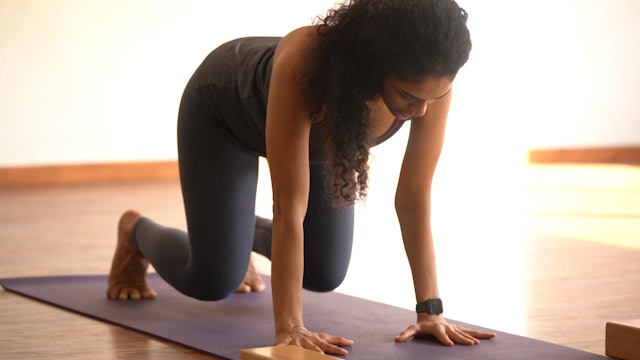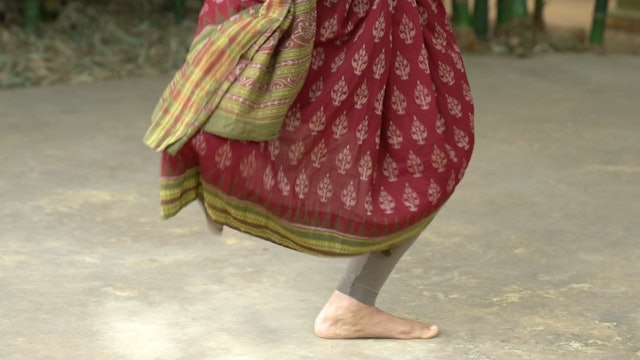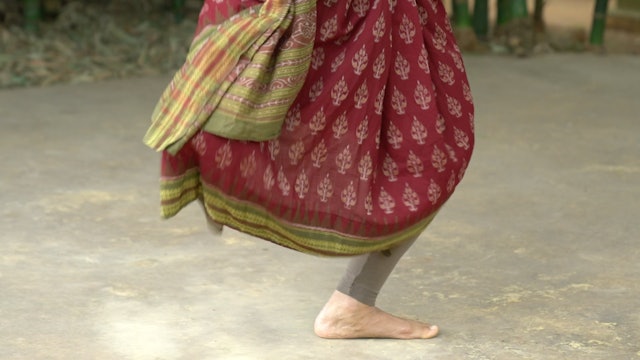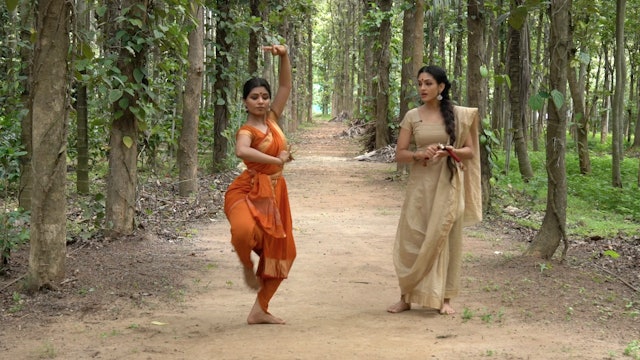-
Warm up : Isolations
The warm up changes in length and content as your body changes. What a conditioned body needs to warm up is very different than a body that is beginning this journey. This warm up is safe and helps a dancer at every level to find openness in the body. It can be done in combination with the hip op...
-
Legs and Core 2
This 25 minute workout, concentrates on your legs and core muscles. It is part of the initial series of instructed videos that have verbal cues at every step. Please pause if you need to, and take a break where necessary. It has a very small portion that has explosive movements. There is an optio...
-
Thattadavu 1
The Thattadavu introduces concepts of rhythm to the beginner student through various patters of striking the floor with the foot. Do these in sequence to progressively build clarity in the articulation of the foot with the floor. Keep your hips stable and try not to move from side to side. It is ...
-
Thattadavu 3
The Thattadavu introduces concepts of rhythm to the beginner student through various patters of striking the floor with the foot. Do these in sequence to progressively build clarity in the articulation of the foot with the floor. Keep your hips stable and try not to move from side to side. It is ...
-
Thattadavu 7
The Thattadavu introduces concepts of rhythm to the beginner student through various patters of striking the floor with the foot. Do these in sequence to progressively build clarity in the articulation of the foot with the floor. Keep your hips stable and try not to move from side to side. It is ...
-
Naatadavu 1
This Adavu has a stretching action in the leg where the foot is flexed and the heel is placed on the floor. The alignment of the hip bones is important in this. The turn-out and stability in the Araimandi position of the dancer must have developed by the time he/she starts the Naatadavu. If this ...
-
Naatadavu 2
This Adavu has a stretching action in the leg where the foot is flexed and the heel is placed on the floor. The alignment of the hip bones is important in this. The turn-out and stability in the Araimandi position of the dancer must have developed by the time he/she starts the Naatadavu.
The se...
-
Naatadavu 3
The third Naatadavu stretches the leg out to the front. If you are unable to keep your back straight when doing this, please refer to the flexibility section and practice the tips for forward bends and try again.
-
Naatadavu 4
The 4th Naatadavu expects a little more stability in the body. Please practice any of the Strength sections that work on lunges and squats, to achieve a deep lunge in this Adavu.
-
Naatadavu 5
The 5th Naatadavu is fairly easier to execute if you are clear with the 3rd and 4th Naatadavu. The bend is in the diagonal, and the length of the back must be maintained. The Swastikam introduced in the second Naatadavu is used again. So as long as there has been clarity so far, this will be an e...
-
Naatadavu 6
If you are unable to get up from the Muzhumandi position on the beat in the 3rd speed, please revisit the leg strength exercises in the exercise section. Pay special attention to the side squats. Also practice the hip- opener exercises that are present in the flexibility section.
-
Pakkadavu
The feet articulation vary in varieties of Pakkadavus. The arms can also be changed and expand to include a number of different types. The Raadha Kalpa method has chosen a specific combination of feet articulation and arm movement to allow the dancer to be able to adapt and vary in choreography a...
-
Pakkadavu 1
Pointers for Pakkadavu 1:
Watch the level of your arms. Make sure you maintain the length of your neck. Turn to the side with your head straight, without tilting. Keep your eyeballs in the centre of your eyes. When you reach to the side, do not raise the opposite elbow. maintain length.
The ...
-
Pakkadavu 2
Pointers for Pakkadavu 2:
Keep your shoulders down when stretching your arms.
Keep the height of the arm that you are looking away from. It is common to let this arm go too far back or let it drop below shoulder height.
Keep your head straight when you look to the side.
Make sure you keep you... -
Pakkadavu 3
Pointers for Pakkadavu 3:
Keep your shoulders down when lifting your arms.
Make sure your arms do not go too far back.
Follow your arm and keep your gaze toward the wrist of the arm you are bending away from.
Make sure you keep your thighs pushing back while retaining Swastikam in your feet.
... -
Pakkadavu 4
Pointers for Pakkadavu 4:
- Keep your shoulders down when lifting your arm.
- Make sure your arm in front of your chest doesn't cross the centre of your chest.
- Make sure you do not sit in your hip when lifting one leg. Keep the thigh pushing back on the standing leg
- do not rest your raised ... -
Kuditta Mettadvau
As mentioned in the Tattu mettaduvu, 'mettu' is a movement that comprises of a heel drop. Kuditta Mettaduvu or Yegar Mettaduvu, has a small jump onto the balls of the feet and then a drop of the heels. This Adavu is varied primarily with arm and torso movements. It is one of the only Adavus that ...
-
Kuditta Mettaduvu
Pointers for Kuditta Mettadavu:
Try to go down instead of hopping up each time you snatch onto your heels.
Keep dropping your tailbone and pushing your thighs back.
When you bend to the side, try not to have any form of a forward bend.By the time you progress to the Kuditta mettadavu, your l...
-
Sarvalaghu Jathi 1
This Jathi has an instructional video. The counts for all the Sarvalaghu Jathis are all in 4 counts. Please watch and try to learn the Jathi for practice.
Please keep in mind that the Raadha Kalpa method likes to reinforce the idea of neutrality in Nritta patterns that are not placed within a c...
-
Sarvalagujathi 2 : Instructions
The instructions teach the Jathi step by step so you can follow and understand with clarity.
-
Sarvalaghu Jathi 2
This Jathi does not have an instructional video. The counts for all the Sarvalaghu Jathis are all in 4 counts primarily. There are small variations in this particular Jathi. Please watch the Tala Theory video after you learn the Jathi and try to analyse where the variations occur.
Please keep ...
-
Talam: Lecture 2 , Speeds
This short lecture deals with the idea of speeds in Rhythm. It explains how the number of syllables in a beat change, and how it affects movement choices.
The speed we choose defines the number of syllables in a beat. The number of syllables will double with every increase in speed.
-
Asamyukta Hasta
The Asamyuta hastas, as described in the Abhinaya Darpana are 28 in number.
These Hastas are used as embellishments in adavus as well as to communicate meaning gesturally, The Viniyogas in the Abhinaya Darpana describe a number of possible gestural implications for each Hasta.
Please refer to...
-
Samyukta Hasta
The Asamyuta hastas, as described in the Abhinaya Darpana are 28 in number.
These Hastas are used primarily communicate meaning gesturally, The Viniyogas in the Abhinaya Darpana describe a number of possible gestural implications for each Hasta.
Please refer to the Shloka below for pronunciat...

























